Eco-Luxe Safari
 African painted dogs, often called wild dogs, are approaching extinction on the continent. Within fifteen minutes of landing at the red-dirt Selinda airstrip in northeast Botswana, on the second of our small plane hops from Zimbabwe, we are parked in a land cruiser staring at 9 of them lolling no more than 20 feet away in the dappled shade of a couple of palm trees. Brindled black and brown, with large oval ‘radar’ ears, these keen hunters are among the most endangered of African mammals. There are estimated to be only 3-5,000 painted dogs left in a handful of countries, where over a half million once roamed southern Africa. Our rare-game luck continues when fifteen minutes later, we creep up on a pair of cheetah languidly
African painted dogs, often called wild dogs, are approaching extinction on the continent. Within fifteen minutes of landing at the red-dirt Selinda airstrip in northeast Botswana, on the second of our small plane hops from Zimbabwe, we are parked in a land cruiser staring at 9 of them lolling no more than 20 feet away in the dappled shade of a couple of palm trees. Brindled black and brown, with large oval ‘radar’ ears, these keen hunters are among the most endangered of African mammals. There are estimated to be only 3-5,000 painted dogs left in a handful of countries, where over a half million once roamed southern Africa. Our rare-game luck continues when fifteen minutes later, we creep up on a pair of cheetah languidly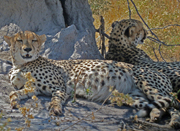 curled up in the shade of a termite mound. They stretch, yawn and calmly flick their black-tipped tails through the tawny grass. A half hour later we roll into our last camp of the trip, Zarafa, which sits on the edge of the Zibadianja Lagoon in the Selinda Reserve. Tessa and Stewart, the camp managers welcome us warmly with cool face towels and introduce us to the camp.
curled up in the shade of a termite mound. They stretch, yawn and calmly flick their black-tipped tails through the tawny grass. A half hour later we roll into our last camp of the trip, Zarafa, which sits on the edge of the Zibadianja Lagoon in the Selinda Reserve. Tessa and Stewart, the camp managers welcome us warmly with cool face towels and introduce us to the camp.
 Four tent suites and a main camp area with dining room, bar, library and lounge tent and veranda comprise the guest facilities—home for several days at a time for 8 lucky safari goers. Our tent, #4, at the end of the line, consists of a large living room with campaign-style furnishings, Kilim rugs, a chest bar, spacious separate bedroom with netted king bed and wardrobe and dressing area. Past the bedroom is a large bathroom with
Four tent suites and a main camp area with dining room, bar, library and lounge tent and veranda comprise the guest facilities—home for several days at a time for 8 lucky safari goers. Our tent, #4, at the end of the line, consists of a large living room with campaign-style furnishings, Kilim rugs, a chest bar, spacious separate bedroom with netted king bed and wardrobe and dressing area. Past the bedroom is a large bathroom with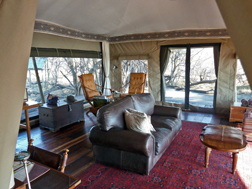 double brass-bowl vanity, open shower, a huge copper bathtub, separate toilet tent, and 20 feet down a short walkway an outdoor, lagoon-view shower.
double brass-bowl vanity, open shower, a huge copper bathtub, separate toilet tent, and 20 feet down a short walkway an outdoor, lagoon-view shower.
 The view is steel-blue water dotted with small grass and reed choked islands; hippos blowing, and various water birds gliding, swimming or fishing. Acacia and fan palm trees define the far shore against the horizon. Along another short deck off the living room side sits a small private plunge pool filled with delightfully chilly water. Pool, deck and tent are all shaded by a broad ebony tree and surrounded by a Zambian Teak forest.
The view is steel-blue water dotted with small grass and reed choked islands; hippos blowing, and various water birds gliding, swimming or fishing. Acacia and fan palm trees define the far shore against the horizon. Along another short deck off the living room side sits a small private plunge pool filled with delightfully chilly water. Pool, deck and tent are all shaded by a broad ebony tree and surrounded by a Zambian Teak forest.
Animals of all sorts routinely roam the area, so some caution is necessary when walking from tent to camp in order to avoid an unpleasant encounter with a buffalo, elephant, or even leopard. Before dawn and after dusk, escort by one of the guides or managers is mandatory. We think at first that this must be a bit of theater, but after we’ve come face-to-face with a bull elephant rounding a corner on the path, and hear about one of the camp managers’ confrontation with leopard in camp, we realize the vigilance is justified.
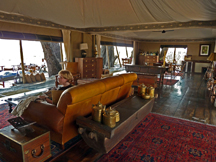 To call this a luxury safari camp is an enormous understatement; it’s the most luxurious camp we’ve ever stayed at. But that opulence ties in with a commitment to conservation by the operating company. Selinda Reserve is a 300,000 acre private concession, leased for 10 years from the local government. There are three small camps, including Zarafa in the entire reserve, which works out to around 20,000 acres of land per room. Great Plains Conservation, the concession holder and operator is comprised of a small group of ecologically-minded friends including conservationists and noted wildlife filmmakers Derek and Beverly Joubert, Wilderness Safaris founder Colin Bell, and World Wildlife Fund South Africa Chairman Mark Read. They state that Great Plains is “less about laying claim to a vast tract of precious land, than it is stewardship, sustainability and conservation.”
To call this a luxury safari camp is an enormous understatement; it’s the most luxurious camp we’ve ever stayed at. But that opulence ties in with a commitment to conservation by the operating company. Selinda Reserve is a 300,000 acre private concession, leased for 10 years from the local government. There are three small camps, including Zarafa in the entire reserve, which works out to around 20,000 acres of land per room. Great Plains Conservation, the concession holder and operator is comprised of a small group of ecologically-minded friends including conservationists and noted wildlife filmmakers Derek and Beverly Joubert, Wilderness Safaris founder Colin Bell, and World Wildlife Fund South Africa Chairman Mark Read. They state that Great Plains is “less about laying claim to a vast tract of precious land, than it is stewardship, sustainability and conservation.”
Great Plains turns over about 20 percent of its profits to the local community, as well as substantial lease payments, for which the tribal landowners create and sustain a viable conservancy in the reserve. So the business model is to provide absolutely the best of the best, and charge high rates for it to those who want that quality. Derek Joubert states: “With so few guests and such high standards, the only way to guarantee sustainability is with an appropriately high fee”. And the staff/guest ratio is appropriately high to match. Tessa Campbell and Stewart Bell (soon to become Campbell-Bell) manage Zarafa with a staff of 19, including the three guides Moses, Steve and Dukes.
Zarafa was also designed to be as ecologically efficient as possible. A solar farm tucked into the woodland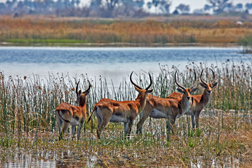 behind the camp provides all power for lights, fans, ice machine, freezers, water pumps and the waste processing system—no generator or fuel are used. Nor for the camp’s 4×4 land cruisers, which are run primarily on recycled cooking oil. A solar water heating system sits near each tent to provide plenty of hot water.
behind the camp provides all power for lights, fans, ice machine, freezers, water pumps and the waste processing system—no generator or fuel are used. Nor for the camp’s 4×4 land cruisers, which are run primarily on recycled cooking oil. A solar water heating system sits near each tent to provide plenty of hot water.
When Great Plains took over the lease in 2006, 80% of the Selinda Reserve was utilized for trophy hunting. On the first day of their occupancy, they halted all hunting. Since then, the wildlife has rebounded both in density and disposition. Elephants, which were once edgy, now sense safety and calmly drink near the camp. Prides of lion, once decimated by the loss of dominant males and reproductive females, are growing and re-establishing territories. In general, the whole area seems to be undergoing a rebirth.
The preserve sits in an area called the Selinda Spillway, which is essentially an eastward extension of the vast Okavango Delta. This area goes through 8-9 year rainfall cycles, and was dry and all but devoid of water though most of the last decade. The rains of 2009 and 2010 were very good, and the water pushed way in creating many lagoons and marshes—including re-forming the one in front of us. Those changes also altered the game composition. Much of the game that was concentrated here was freed by water availability to spread out further, resulting in less dense herds and game in general. Over the course of our four days here, we will see virtually all of the animals, but in smaller groups: 8-10 impala, half-dozen red lechwe, 2-3 Kudu, a pair of warthogs half-dozen elephant, a pod of 4-5 hippos, a trio of lions, and a ‘journey’ of giraffes (journey being the odd collective noun for giraffes), The single large herd we’ll encounter will be 150 or so buffalo.
 Sitting on the deck that first afternoon, gin and tonic in hand, we watch elephant pass directly in front of camp, then cross the lagoon up to their chest. Hippos snort and yawn enormously, showing their ivory teeth, and a young croc slips noiselessly into the water while the glossy starlings swoop and the buffalo weavers call raucously in the trees in the trees able. A nap, a dip in the cold pool to cool off, and down to the main camp for a spot of
Sitting on the deck that first afternoon, gin and tonic in hand, we watch elephant pass directly in front of camp, then cross the lagoon up to their chest. Hippos snort and yawn enormously, showing their ivory teeth, and a young croc slips noiselessly into the water while the glossy starlings swoop and the buffalo weavers call raucously in the trees in the trees able. A nap, a dip in the cold pool to cool off, and down to the main camp for a spot of  afternoon tea before setting out at 4 for evening game drive. We rack up a few giraffe—always so elegant and graceful to watch—a family of warthogs, beautiful male kudu with full triple-twisted horns, a couple of reedbucks and lots of bird life: lilac crested roller, saddle billed stork, red billed hornbill, carmine bee eater and a hunting fish eagle.
afternoon tea before setting out at 4 for evening game drive. We rack up a few giraffe—always so elegant and graceful to watch—a family of warthogs, beautiful male kudu with full triple-twisted horns, a couple of reedbucks and lots of bird life: lilac crested roller, saddle billed stork, red billed hornbill, carmine bee eater and a hunting fish eagle.
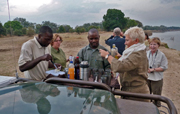 As the sun nears the horizon, Moses pulls the land cruiser under an ebony tree, the bar unfolds from the front grill and gin and tonics plus some nibbles materialize for the daily tradition of ‘sundowners’ in the bush. After dusk, an hour’s search in the dark for the secretive leopard or wild dogs on the hunt ends without success and we return to camp at 7:30 for cocktails before dinner.
As the sun nears the horizon, Moses pulls the land cruiser under an ebony tree, the bar unfolds from the front grill and gin and tonics plus some nibbles materialize for the daily tradition of ‘sundowners’ in the bush. After dusk, an hour’s search in the dark for the secretive leopard or wild dogs on the hunt ends without success and we return to camp at 7:30 for cocktails before dinner.
Food at Zarafa is several notches above other camps we’ve stayed at on this or most other trips. The bar is incredibly well stocked, and the wine selection is fairly broad and very good quality—mostly South African. A Mulderbosch Sauvignon Blanc and Caldera, a Rhone like blend of mourvedre, grenache & syrah both both prove delightful. Dinner might start with soup—squash/avocado one night—or a polenta disk with grilled eggplant, mushrooms and haloumi cheese. There is always a choice of main course, and narry a buffet. Perhaps lamb loin, stuffed turkey roll, grilled bream—and always one vegetarian dish. Vegetable curry was a stand-out one evening. And a perfectly rare-grilled filet of beef another. Some guests head to their tent right after dinner, around 10. Others of us linger around the fire in the cooling night air sipping a peaty malt whiskey and telling Africa stories as the bell frogs and cicadas pulsate in the background.
always a choice of main course, and narry a buffet. Perhaps lamb loin, stuffed turkey roll, grilled bream—and always one vegetarian dish. Vegetable curry was a stand-out one evening. And a perfectly rare-grilled filet of beef another. Some guests head to their tent right after dinner, around 10. Others of us linger around the fire in the cooling night air sipping a peaty malt whiskey and telling Africa stories as the bell frogs and cicadas pulsate in the background.
 The fact that Selinda is a private concession makes a couple of key differences to the safari experience, as contrasted to camps that are in national parks. First, walking safaris are permitted, allowing a very close connection to the bush. Second, vehicles can go off-road for ‘bush driving’ thus greatly increasing the chance of seeing some of the more difficult animals such as leopard or cheetah, and elusive nocturnals such as African wild cat or honey badger. One late afternoon, driving next to a stand of ebony and mangosteen trees, Moses hears squirrels and francoline giving warning calls. We just see a group of impala back in the
The fact that Selinda is a private concession makes a couple of key differences to the safari experience, as contrasted to camps that are in national parks. First, walking safaris are permitted, allowing a very close connection to the bush. Second, vehicles can go off-road for ‘bush driving’ thus greatly increasing the chance of seeing some of the more difficult animals such as leopard or cheetah, and elusive nocturnals such as African wild cat or honey badger. One late afternoon, driving next to a stand of ebony and mangosteen trees, Moses hears squirrels and francoline giving warning calls. We just see a group of impala back in the bush looking around nervously. Two vultures land in a nearby tall dead tree. All signs of leopard, said Moses. The impala begin to cough their warning call, so we bump off the track and slowly drive over logs and bend over small trees and large bushes in search of the spotted cat. Alas he is too elusive, but the experience of recognizing the signs, and be able to go into the brush in search, rather than just tooling around the roads hoping, is terrific.
bush looking around nervously. Two vultures land in a nearby tall dead tree. All signs of leopard, said Moses. The impala begin to cough their warning call, so we bump off the track and slowly drive over logs and bend over small trees and large bushes in search of the spotted cat. Alas he is too elusive, but the experience of recognizing the signs, and be able to go into the brush in search, rather than just tooling around the roads hoping, is terrific.
The next morning we drive out at sunrise to go on a walking safari, but are distracted from that objective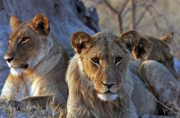 when we spot three lions—a lioness and two year-and-a-half old males—resting on a termite mound two minutes from camp. We watch and photograph for a half hour, and when they stand up to wander off, follow then into the brush. We have to drive around a very thick patch, and rounding a clump of brush see a lone giraffe looking around in alarm. One of the young males emerges from the brush and starts to give chase as the tall one bounds off, but he looks more like a gamboling kitten at play than a serious hunter. Giraffe can defend themselves furiously with vicious kicks, and it takes more
when we spot three lions—a lioness and two year-and-a-half old males—resting on a termite mound two minutes from camp. We watch and photograph for a half hour, and when they stand up to wander off, follow then into the brush. We have to drive around a very thick patch, and rounding a clump of brush see a lone giraffe looking around in alarm. One of the young males emerges from the brush and starts to give chase as the tall one bounds off, but he looks more like a gamboling kitten at play than a serious hunter. Giraffe can defend themselves furiously with vicious kicks, and it takes more 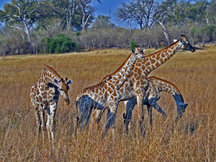 than one young lion to do one in.
than one young lion to do one in.
Moses had told us when we saw the wild dogs on the first day that we’d check their den at some point, and shortly we move slowly up to a hillock criss-crossed with logs and see the four youngest pups—perhaps several months old—which have been left for safekeeping while the pack hunts. They sniff curiously at the edge of the den, and stare out intently, then soon creep cautiously out to explore with puppy curiosity. The pack must have hunted successfully last night, as their stomachs are quite well rounded. 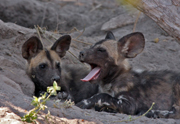
For our last evening, we chase after game for an hour or so, then board the camp’s boat, the HMS Zibadianja for a cruise around the lagoon. Built just last year, the boat is a large wood-floored pontoon raft with thatched roof, furnished as a comfortable living room—Kilim rugs, two easy chairs, a leather couch, dining table and bar. We motor slowly around the floating reed islands watching hippo antics, elephants crossing to 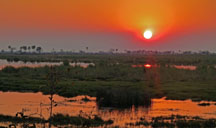 the islands to feed, and a great variety of birds. Moses breaks out the sundowners as the sun turns sky and water to a glowing burnt orange with the reeds and palm trees a mere black silhouette. After dusk we search further for leopard, civet and cerval cat in the same area where we’d observed the warning signs the night before, but our only sighting is a quick spot of the shy African wild cat.
the islands to feed, and a great variety of birds. Moses breaks out the sundowners as the sun turns sky and water to a glowing burnt orange with the reeds and palm trees a mere black silhouette. After dusk we search further for leopard, civet and cerval cat in the same area where we’d observed the warning signs the night before, but our only sighting is a quick spot of the shy African wild cat.
As we wind our way back to camp, it seems to me that Moses is heading somewhat the wrong direction. There are some lights in the distance, and I think, “well, my sense is off”. As we approach it looks like a lot of lanterns on the ground and in trees, and he says “I’m just going to see what these guys at this army camp are doing.” I buy his line for a beat or two, until we are close enough to see that the ‘army uniforms’ say Selinda Reserve, and we recognize Stewart and Tessa. Surprise dinner in the bush. 
Stars overhead, a circle of trees, camp kitchen with barbecue, and a ring of individual tables around a roaring campfire, white linen and glassware gleaming in the lamplight. A camp bar of course, and the other two land cruisers rumble to a stop as we’re pouring vodka over ice cubes. A half-hour cocktail conversation over who saw what: giant eagle owl; wild dogs hunting; cerval cat; the three lions not seeming interested in hunting. Dinner gong sounds, and we sit to bowls of lovely bright green fresh pea soup with a crisp South African chenin blanc. Then, a line for the barbecue, ladies called first. Coils of beef sausage and chicken sizzling on the grill; an enormous Dutch oven of fork-tender braised lamb shanks; phaletshe, the Botswana word for the ubiquitous African mainstay of cornmeal mush, with tomato and onion sauce and spiced sautéed spinach. After supper Stewart pours us a brandy to enjoy as the fire fades to embers. We could try and recreate this magic at home, but for the high fire danger in Sonoma, and, of course, the lack of staff.
brandy to enjoy as the fire fades to embers. We could try and recreate this magic at home, but for the high fire danger in Sonoma, and, of course, the lack of staff.
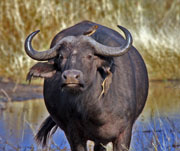 The next morning, our day of departure, we elect to relax in camp and enjoy the cool of early day. Over coffee and toast and camp-made muesli delivered to our tent, a sort of mini-game drive comes to us. Baboons chatter and fight in the trees above, occasionally scampering down the tent roof, and hippos snort in the pool. A vivid lilac and turquoise bee-eater dips in and perches in the golden morning sun for a minute. A buffalo with red-beaked Ox-peckers astride stares morosely as stately great white pelican lands in front of us in
The next morning, our day of departure, we elect to relax in camp and enjoy the cool of early day. Over coffee and toast and camp-made muesli delivered to our tent, a sort of mini-game drive comes to us. Baboons chatter and fight in the trees above, occasionally scampering down the tent roof, and hippos snort in the pool. A vivid lilac and turquoise bee-eater dips in and perches in the golden morning sun for a minute. A buffalo with red-beaked Ox-peckers astride stares morosely as stately great white pelican lands in front of us in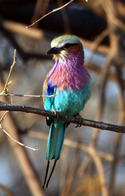 the lagoon, coming in like an old flying boat, and starts to fish. And finally one of the painted wild dog pack lopes up to water’s edge. He stops and looks at us momentarily—his piebald face in the dappled sun seeming to say “this is why you come to Africa”.
the lagoon, coming in like an old flying boat, and starts to fish. And finally one of the painted wild dog pack lopes up to water’s edge. He stops and looks at us momentarily—his piebald face in the dappled sun seeming to say “this is why you come to Africa”.